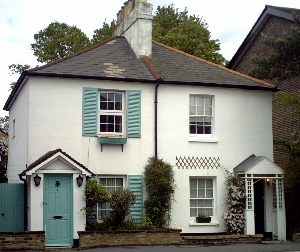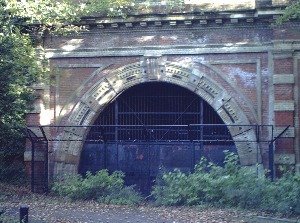
Additional Information
|
An Upper Norwood Walk Additional Information |
| london-footprints.co.uk |
[Beaulieu Heights] [The Crystal Palace] [Gipsy Tower] [The Great North Wood] [High Level Railway] [The Lawns] [Stambourne Woodland Walk] [Upper Norwood Recreation Ground] [Westow Park]
THE
GREAT NORTH WOOD
The district of Upper Norwood was for centuries part of the Great
North Wood. These woods had provided timber for ships &
building and the coppiced wood had been used for fuel &
charcoal production. It had also provided land on which to keep
animals, especially pigs and for hunting. The Enclosure Acts
dispossessed many people by parcelling the woods and commons into
owned properties. However at the beginning of the 19th century it
was still a rural place peopled by gipsies and other, less
desirable, characters.
THE
CRYSTAL PALACE
This was designed by Joseph Paxton to house the Great Exhibition
in Hyde Park during the summer of 1851. Such was its success that
a company was formed to buy the building and re-erect it on a 300
acre site at Sydenham. Between 1852-4 it was rebuilt on a larger
scale with 6 storeys and 3 transepts. With some 2 million
visitors a year it was London's most visited attraction initially
but interest waned and its high costs meant it never made a
profit. It struggled on with highs and lows until it was finally
destroyed in a spectacular fire in November 1936. However the
siting of the palace had led to the development of Anerley, Penge
and Sydenham during the Victorian period. The London Brighton
& South Coast Railway (Low level) had opened at the same time
as the palace and the London Chatham & Dover (High level)
followed in 1865.
STAMBOURNE WOODLAND WALK
This was once gardens of large Victorian villas but as these fell
into disrepair it became an area of dense scrub and trees. The
project to develop it began in 1962 with the purchase of the
land, some of which belonged to the Church Commissioners. Paths
and seats were put in and additional planting was undertaken. It
opened in 1984.
BEALIEU
HEIGHTS
Originally part of the Great North Wood it later became the
grounds of two large houses, Hazelwood and Beaulieu Lodge. The
latter became a hotel and then an old people's home. The park was
formed when the land was purchased from the Church Commissioners
in 1938 although it was not opened until after the war. The park
suffered a damaging fire in 1976 when a large area of the oak
wood was destroyed.
THE LAWNS
This had a noted medicinal spa which in 1831 was developed as a
place of entertainment with gardens laid out by Decimus Burton,
who also designed the Spa House and the Lodge. Features in the
grounds included rose gardens, a maze, lakes with waterfowl &
a camera obscura and there were fine views. Entertainments
included concerts, dancing, archery, fireworks and floral
exhibitions. Visitors were encouraged to bring picnics and could
hire cutlery & crockery. The spring was located under a
thatched-roofed structure. Some water was frozen or bottled and
sold at 2/- a gallon. Admission was by weekly or annual
subscription. Non-subscribers were admitted on Mondays but
servants in livery were not allowed. Horse drawn coaches brought
visitors from Charing Cross three times a day until in 1839 the
London & Brighton Railway opened. The Spa's popularity
declined after the opening of the Crystal Palace in 1854 and in
1858 the estate was put up for auction. Some of the area was
developed and a large mansion called 'The Lawns' was built
although this was demolished after a fire in the 1960s. In 1939
the Lawns became a public open space and the former hotel &
hydro was replaced by the Beulah Spa pub. The original lodge,
known as Rustic Lodge, where uniformed gatekeepers collected the
fees, remains as a private house now called Tivoli Lodge. The
thatched roof has been replaced with slate and a conservatory and
extra floor added.
UPPER NORWOOD RECREATION GROUND
This was purchased in 1890 and laid out by the Borough Surveyor.
It included sports facilities and allotments (since lost to
additional sports ground). It contains one of the head waters of
the River Effra which has now been culverted.
WESTOW
PARK
This small recreation ground was enlarged in 1970 when the
grounds of two large houses, Windermere & Walmer, were added
along with part of the pre-fab estate at College Green.
Windermere House had been converted and enlarged in 1873-6 to
serve the Royal Normal College and Academy of Music for the
Blind. Walmer House was also used by this establishment until
purchased by Croydon Council. The grounds included a large pond
beside Bedwardine Road which has since been filled in and some
large Horse Chestnut trees which remain.
|
GIPSY TOWER When the nave of Christ Church burned down in 1982 the congregation opted to move to a purpose-built church next door. The remaining 120' foot tower was converted to a four-bedroomed house in 1996 when an extension with a roof garden was added. The tower room is 12' square but 40' high with views across to Hackney and some original stained glass. |
| HIGH LEVEL RAILWAY Started in 1862 by the Crystal Palace and South London Railway (later the London Chatham & Dover) Opened in August 1865 Line from Nunhead to terminus Station building by EM Barry with refreshment rooms Subway under Parade at north end with cream & terracotta brick vaulting by Italian craftsmen (air raid use in WWII) 45' turntable (south) 439 yard Paxton Tunnel (north) Lordship Lane & Honor Oak Stations 1865, Nunhead 1871, Upper Sydenham 1884 Re-named Crystal Palace & Upper Norwood 1895 Closed WWI 1917-9 Became Southern Railway in 1923 (re-named High Level) Electrified in 1925 Closed to traffic 1944-6 and used for storing rolling stock Some war time damage Last train and steam special September 1954 Lines taken up in 1956 Station demolished 1961 - houses built on site |
 Entrance to Paxton Tunnel |
RESOURCES
Croydon Parks - An Illustrated History by Mrs M A Winterman
Crystal Palace - Norwood Heights by Audrey Hammond
The Croydon Society has produced 2 publications: Conservation
Areas of Croydon and Croydon's Built Heritage which have
information on the area.
There is a Crystal Palace Museum housed in the old engineering
school on Anerley Hill. Admission is free and it is open
Saturdays, Sundays & Bank Holiday Mondays 11-4:30 or by
arrangement for groups. Tel 020 8676 0700.
london-footprints.co.uk 2009
[route & what to see] [walks list]